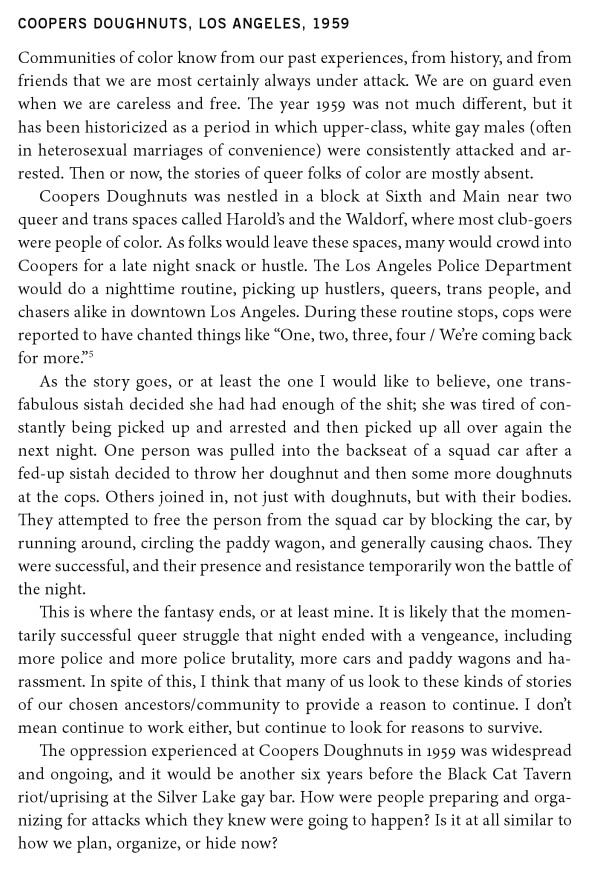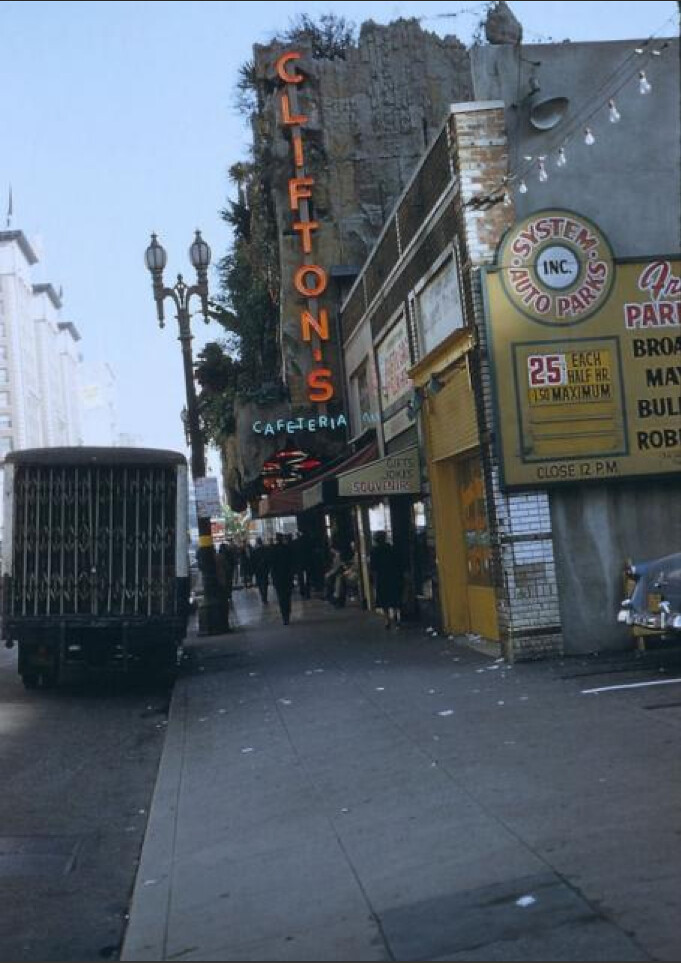Quote:
Originally Posted by HossC


Going through the 1956 and 1960 City Directories, I've found the following. In 1956 there was a business called Cooper's Wholesale Doughnuts at 215 S Main Street. Neither the business nor the address appear in 1960. At 628 S Olive Street you'll find Cooper's Doughnuts in both CDs, as well as Cooper's Donuts at 316 E 5th Street. The 1960 CD also has Cooper's Do-Nuts at 1018 E 7th Street. After that, Cooper's Donuts at 316 E 5th Street appears in the 61, 62 and 63 CDs, while the business at 628 S Olive Street is listed as Coopers Doughnut (no apostrophe or final "s") in 61 and 62, and as Coopers Doughnuts (regaining its "s") in 63, 64 and 65. It looks like all the variant spellings are used in references to the riot.
Like most accounts that are available online, the version below claims that Coopers Doughnuts was near Harold's and the Waldorf on Main Street, which doesn't fit with any of the addresses above. It's from 'Beyond Walls and Cages: Prisons, Borders, and Global Crisis' edited by Jenna M Loyd, Matt Mitchelson, Andrew Burridge.
 books.google.com
books.google.com
The same Main Street location is mentioned in the paragraph below. It's from an article called 'Block Party: Main Between Fifth and Sixth Streets' on ladowntownnews.com.
Doughnuts and Gay L.A.: The Nickel Diner, which opened last year, almost instantly became a neighborhood favorite. Brunch draws crowds outside the small storefront at 524 S. Main St. every weekend and many come to experience the now famous maple glazed bacon donut. But the Nickel isn’t the first Main Street outpost to hawk those sweet dough rings: Cooper’s Doughnuts, which once occupied a small building on the west side of the street — where a Five Star parking lot now stands — was a popular 24-hour hangout for the gay community, according to Lillian Faderman and Stuart Timmons’ book Gay L.A. In 1959, 10 years before the Stonewall riots in New York helped ignite the national gay rights movement, Cooper’s patrons clashed with police officers who had allegedly harassed customers. Now all we need is a photograph! |
HossC, thanks for digging up those addresses! I know I had done that once upon a time, and wish I had kept some records (and didn't have it in me to get after them last night, on Christmas Eve).
Yes, the 215 S Main doesn't jive with the 1959 riot story since the building there was a parking lot by the end of '58.
I recall that, having found the 5th St address, thought it most likely for
Exiles, and hipped the guy who runs Reel SF,
so it's now on his site as there on 5th. That never really sat well with me though, as it's blocks and blocks from where Mackenzie shot most of the film locations—I have since discovered evidence of the Cooper's on the 400 block of S Hill, in the Theodore Hall images at the Getty. I need to write the fellow who runs the ReelSF blog and let him know!
Plus it doesn't really work with the story anyway, the address on 5th is too far from The Run, all the way on the other side of Wall. If we're talking about the Cooper DN on S Hill by Pershing Square, that would actually make sense, in that it was right there in the cruising circuit.
The 628 Olive address is here, adjacent Clifton's, which was demolished in '60 (Coopers Doughnuts would be the part with the yellow roll-down):
 tikiroom
tikiroom
Again, what's worrying is that the primary sources aren't there, a problem for something that appears to be accepted fact. Look at the two references above, for example; in
Beyond Walls and Cages, published by University of Georgia in 2012, you'll note there's not even a footnote for the story. It is, apparently, again referencing the 2005 Rechy interview. (Note there is a citation for the part about the police chanting at the transexuals—which comes from pp. 1-2 of Faderman & Timmons'
Gay LA—but I couldn't track down the primary source for that, and to be honest, while I'm no expert on the LAPD, it seems anachronistic, dubious.) The ladowntownnews.com story is also taken from Faderman & Timmons' 2006 book; they reference the event and were apparently the first to add the "between the Waldorf and Harold's" part of the story. Unfortunately, googlebooks is omitting the first pages and the footnotes so I'll have to get my hands on an actual copy to see their source, unless someone out there has one!
Let me be clear, I'm not saying it didn't happen or that it wouldn't be an important part of our collective history. However; it's common currency among police officers, for example: eyewitness testimony is the least reliable or credible. And here we have a major event being told 45+ years after it occurred, and the fact-checking is being difficult. That even random, desultory fact-checking would never occur before the event is consigned to academic publishing is, unfortunately, just the state of academia and journalism. But nothing gets by the architectural and cultural historians of NLA, dammit!